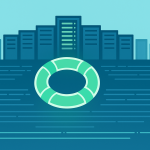The Digital Fortress: Why Your Host is Your First and Last Line of Defense
If your website is an important business asset, a source of income, or a critical communication tool, then protecting it from hackers isn’t a task—it’s an absolute necessity.
Think of your website as a physical building. You can install the best locks on the front door (your login page), but if the building’s foundation is weak, the windows are cracked, and the external walls have holes, a determined burglar (a hacker) will find a way in.
In the digital world, your web host is the foundation and the walls of your building. While popular guides focus on application-level security (like securing your WordPress plugins), this is only half the story. The truth is, many of the most damaging attacks—from massive data breaches to crippling Distributed Denial of Service (DDoS) attacks—are fought and won (or lost) right at the hosting and server level.
This guide is your complete, step-by-step roadmap to building an impenetrable digital fortress using the powerful, often technical, tools provided by your hosting provider. We’re going deep, but we’re keeping it simple and actionable.
Part I: The Core Pillars of Hosting-Level Security
No matter what kind of hosting you have—Shared, VPS, Dedicated, or Cloud—these three practices are your foundational security pillars. They represent the non-negotiables of server protection.
Pillar 1: The Unbreakable Backup Strategy
A security breach is a question of when, not if. The most robust security is only as good as its ability to recover. Backups are your ultimate ‘undo’ button. They don’t prevent an attack, but they make the attack irrelevant.
What a Value-Added Backup Strategy Looks Like:
- The 3-2-1 Rule: This is the industry gold standard.
- 3: Have at least three copies of your data (your main site, plus two backups).
- 2: Store the copies on at least two different types of media. (e.g., your host’s server and an external cloud service like Google Drive or Amazon S3).
- 1: Keep at least one copy off-site. This protects you from catastrophic failures like your host’s entire data center experiencing an issue.
- Automated, Daily Snapshots: Your host should offer automated daily backups. If they don’t, set up a cron job or a backup plugin to run at least once a day, or even hourly for high-traffic sites.
- Test Your Restore Process: This is the step everyone skips. A backup is useless if you don’t know how to restore it, or if the files are somehow corrupted. Schedule a test restore of your site to a staging or local environment at least once every quarter to ensure the process works.
Pillar 2: Encryption—The Universal Language of Trust
Encryption ensures that data traveling between your server and a user’s browser is scrambled and unreadable to anyone else.
- Mandatory SSL/TLS (HTTPS): A Secure Sockets Layer (SSL) certificate is non-negotiable in 2025. It changes your site from
http://tohttps://and displays that little padlock icon, encrypting all data in transit. Your hosting provider should offer a free, auto-renewing certificate (like Let’s Encrypt).- Actionable Step: Once installed, ensure your entire site forces HTTPS. A mixed-content warning (when some elements load over HTTP) can still expose visitor data. Most hosts offer a simple toggle, but you may need to add a few lines of code to your site’s main configuration file (
.htaccessor server config) to ensure all HTTP requests are permanently redirected to HTTPS.
- Actionable Step: Once installed, ensure your entire site forces HTTPS. A mixed-content warning (when some elements load over HTTP) can still expose visitor data. Most hosts offer a simple toggle, but you may need to add a few lines of code to your site’s main configuration file (
- SFTP vs. FTP: Always, always use SFTP (Secure File Transfer Protocol) or SSH (Secure Shell) for file transfers. Standard FTP sends your usernames and passwords in plain, unencrypted text, which is incredibly easy for hackers to sniff out. SFTP encrypts this connection. If your host only offers FTP, it’s time to switch hosts.
Pillar 3: The Principle of Least Privilege (PoLP) and Access Control
This principle is simple: every user, application, and process should only have the minimum permissions necessary to perform its required function.
- Restrict File Permissions: Your files and folders have permissions (usually represented by a three-digit number like 755 or 644). Incorrect permissions are one of the most common ways hackers gain access.
- Rule of Thumb: All folders should be 755 (Owner can read, write, and execute; Group and Public can only read and execute). All files should be 644 (Owner can read and write; Group and Public can only read). The
wp-config.php(for WordPress) or similar configuration files should be even stricter, often 600 or 400 to prevent any public writing.
- Rule of Thumb: All folders should be 755 (Owner can read, write, and execute; Group and Public can only read and execute). All files should be 644 (Owner can read and write; Group and Public can only read). The
- Database User Privileges: Your website’s database user should only be able to select, insert, update, and delete data relevant to the website. It should never have super-admin (root) access to the entire database server. If a hacker exploits a vulnerability, this limits the damage to just your website’s data, not the entire server.
- Limit Admin Access: Create specific, non-admin accounts for developers or contractors and revoke their access immediately when a project is complete. Never share your primary hosting control panel (cPanel/Plesk) login.
Part II: Server Hardening and Configuration (The Advanced Host-Level Defense)
This is where you move from basic protection to true server hardening. Many of these features are managed by your host on a shared server, but on a VPS or Dedicated Server, they become your responsibility.
1. The Digital Bouncer: Firewalls (Network & Application)
A firewall monitors all incoming and outgoing network traffic and blocks anything suspicious based on a set of rules.
- Network Firewall (Traditional): This is the gatekeeper at the edge of the server. It’s set up to close every port by default and only open the ones needed (e.g., Port 80 for HTTP, 443 for HTTPS, and a specific, non-default port for SSH). If you manage your own server, ensure your firewall (like UFW or iptables) is active and properly configured.
- Web Application Firewall (WAF): This is a much smarter, website-specific firewall. It examines the actual content of the HTTP traffic—the web requests—to block common web attacks before they reach your website code. A good WAF can stop:
- SQL Injection (SQLi): Attackers inserting malicious database commands.
- Cross-Site Scripting (XSS): Attackers injecting malicious client-side scripts.
- DDoS (Distributed Denial of Service) Attempts: Overwhelming your server with traffic. Many hosts integrate with services like Cloudflare to provide this essential layer of WAF and DDoS protection.
2. Lock Down the Backdoor: Securing SSH
Secure Shell (SSH) is how you remotely command your server. It is powerful and, if compromised, allows a hacker complete control.
- Disable Password Logins (Use SSH Keys): Passwords can be guessed; cryptographic SSH keys cannot. An SSH key is a pair of files: a public key that sits on your server and a private key that sits on your local machine. Only the private key can unlock the connection. This is exponentially more secure than a password.
- Change the Default SSH Port: By default, SSH runs on port 22. Automated bots and scanners constantly check this port. Change it to a high, random number (e.g., 22022). This won’t stop a targeted attacker, but it stops 99% of automated brute-force scanning attempts.
- Disable Direct Root Login: Never allow direct login using the
root(super-admin) user over SSH. Force admins to log in with a normal user account first, and then use thesuorsudocommand to elevate their privileges. This creates a necessary audit trail and another layer of resistance.
3. The Proactive Watchdog: Intrusion Detection & Prevention
These tools are like a security guard patrolling your server 24/7, watching for abnormal behavior.
- Intrusion Detection System (IDS): This software (like OSSEC) constantly monitors your system, looking for signs of a breach: unexpected file changes, suspicious processes, or strange network activity. It alerts you when it finds something.
- Intrusion Prevention System (IPS) & Fail2Ban: This takes the IDS one step further: it acts automatically. Fail2Ban is a common tool that actively monitors your logs for failed login attempts (FTP, SSH, cPanel, etc.). If an IP address tries to log in, say, five times in five minutes and fails, Fail2Ban automatically bans that IP address at the firewall level for a set period. This is essential for stopping brute-force attacks.
4. Housekeeping: Keep a Tidy Server
Every piece of software, library, or port that is active on your server is a potential point of entry.
- Disable Unnecessary Services: If you don’t use a mail server, turn it off. If you don’t use specific PHP modules, disable them. Less active software means a smaller “attack surface” for hackers to target.
- Regularly Audit Software: Remove old or unused themes, plugins, or applications (e.g., an old version of a CMS you no longer use). These are forgotten entry points.
- Keep Everything Updated (The Patching Lifeline): Your Operating System (OS), web server (Apache/Nginx), PHP version, and database (MySQL/MariaDB) must be kept current. Updates aren’t just for new features; they are often critical security patches that close newly discovered vulnerabilities. Running an outdated version of PHP is a welcome sign for a hacker.
Part III: The Day-to-Day User Level Security
Even with the toughest server, a single weak password can bring it all down. This part covers the controls you manage every day.
1. Zero Trust Authentication
- Multi-Factor Authentication (MFA/2FA): This is the single biggest security upgrade you can make to any account. Enable it for your hosting control panel (cPanel, Plesk), your primary website admin login, and any critical third-party services. MFA requires a second piece of information—a code from your phone or a hardware key—in addition to your password. If a hacker steals your password, they still can’t get in.
- Strong, Unique Passwords: Use a password manager to generate long, complex, random passwords for every account. Never reuse passwords. A password phrase (e.g.,
Dog-Ran-Fast-Under-Bridge-2025!) is often stronger than a short, complex password.
2. Proactive Monitoring and Scanning
- Daily Malware Scans: Use a reliable hosting-level malware scanner (many hosts offer integrated tools like Imunify360 or SiteLock) to automatically scan all your website files for suspicious code, hidden backdoors, and known malware signatures.
- Uptime and Performance Monitoring: A sudden, inexplicable spike in traffic or a dramatic drop in performance can be an early warning sign of a brute-force attack or a small-scale DDoS attempt. Set up external monitoring (via a service like UptimeRobot) to alert you to downtime.
- Review Server Logs: Get into the habit of checking your server access logs. Look for unusual patterns: many failed logins from a single IP, or a single IP making an excessive number of requests to strange, non-existent pages.
Conclusion: Security is a Process, Not a Product
In the fast-moving digital landscape of 2025, the hacker’s toolkit is becoming more sophisticated, driven by AI and automation. But your defense can and must be stronger.
The key takeaway is this: You cannot outsource 100% of your security to your web host. You are in a partnership. Your host provides the secure infrastructure (the walls and the roof), but you are responsible for configuring the doors, watching the windows, and enforcing the access rules.
By implementing the advanced, hosting-level strategies laid out in this guide—from the foundational 3-2-1 backup rule to the proactive use of SSH keys and Web Application Firewalls—you stop being an easy target. You move from being vulnerable to being a well-hardened digital fortress, and that is often enough to send a hacker on to the next, softer target. Secure your host, and you secure your future online.



